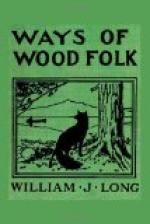If the visitor be very patient, and lie still, he will presently hear the pattering of tiny feet on the leaves, and see the brown birds come running in from every direction. Once in a lifetime, perhaps, he may see them gather in a close circle—tails together, heads out, like the spokes of a wheel, and so go to sleep for the night. Their soft whistlings and chirpings at such times form the most delightful sound one ever hears in the woods.
This call of the male bird is not difficult to imitate. Hunters who know the birds will occasionally use it to call a scattered covey together, or to locate the male birds, which generally answer the leader’s call. I have frequently called a flock of the birds into a thicket at sunset, and caught running glimpses of them as they hurried about, looking for the bugler who called taps.
All this occurred to me late one afternoon in the great Zoological Gardens at Antwerp. I was watching a yard of birds—three or four hundred representatives of the pheasant family from all over the earth that were running about among the rocks and artificial copses. Some were almost as wild as if in their native woods, especially the smaller birds in the trees; others had grown tame from being constantly fed by visitors.
[Illustration]
It was rather confusing to a bird lover, familiar only with home birds, to see all the strange forms and colors in the grass, and to hear a chorus of unknown notes from trees and underbrush. But suddenly there was a touch of naturalness. That beautiful brown bird with the shapely body and the quick, nervous run! No one could mistake him; it was Bob White. And with him came a flash of the dear New England landscape three thousand miles away. Another and another showed himself and was gone. Then I thought of the woods at sunset, and began to call softly.
The carnivora were being fed not far away; a frightful uproar came from the cages. The coughing roar of a male lion made the air shiver. Cockatoos screamed; noisy parrots squawked hideously. Children were playing and shouting near by. In the yard itself fifty birds were singing or crying strange notes. Besides all this, the quail I had seen had been hatched far from home, under a strange mother. So I had little hope of success.
But as the call grew louder and louder, a liquid yodel came like an electric shock from a clump of bushes on the left. There he was, looking, listening. Another call, and he came running toward me. Others appeared from every direction, and soon a score of quail were running about, just inside the screen, with soft gurglings like a hidden brook, doubly delightful to an ear that had longed to hear them.
City, gardens, beasts, strangers,—all vanished in an instant. I was a boy in the fields again. The rough New England hillside grew tender and beautiful in sunset light; the hollows were rich in autumn glory. The pasture brook sang on its way to the river; a robin called from a crimson maple; and all around was the dear low, thrilling whistle, and the patter of welcome feet on leaves, as Bob White came running again to meet his countryman.




